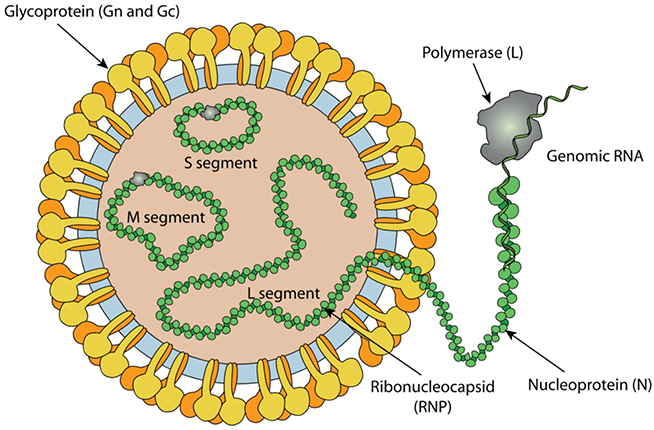
Hantavirus pulmonary syndrome (HPS) is a rare but potentially life-threatening viral illness transmitted to humans through exposure to the infected urine, droppings, or saliva of certain mice and rat species. The disease is caused by hantaviruses, which are single-stranded, enveloped, negative-sense RNA viruses belonging to the family Hantaviridae.
Hantaviruses can lead to severe diseases such as Hantavirus Pulmonary Syndrome (HPS). HPS is one of two potentially fatal syndromes of zoonotic origin caused by species of hantavirus. These include Black Creek Canal virus (BCCV), New York orthohantavirus (NYV), Monongahela virus (MGLV), Sin Nombre orthohantavirus (SNV), and certain other members of hantavirus genera that are native to the United States and Canada.
The hantavirus genome consists of small (S), medium (M), and large (L) segments, encoding three proteins: nucleocapsid (N), glycoprotein precursor (GPC), which is cleaved by host signal peptidase to form Gn and Gc, and RNA-dependent RNA polymerase L (RdRp).
Glycoprotein N (Gn, also known as G1) is receptor binding, membrane fusion and viral morphogenesis. Glycoprotein C (Gc, also konw as G2) forms homotetramers with Gn at the surface of the virion. Attaches the virion to host cell receptors including integrin ITGAV/ITGB3.
Antibodies that bind Gn and Gc have neutralizing activity and provide lasting protection in vivo. They are two important targets to develop effective vaccines and generate neutralizing antibodies.

Figure 1 Schematic representation of Hantaan virus(viralzone)
Nucleocapsid (N) is encoded by S segment with a molecular weight of 50 kDa. It is required for virus replication. Antibodies targeting the nucleoprotein arise rapidly following infection, rendering them a useful biomarker for infection.
RNA-dependent RNA polymerase L (RdRp) which responsible for the replication and transcription of the viral RNA genome, is the largest protein encoded by hantaviruses which derived from the L segment. The RNA-dependent RNA polymerase L (RdRp) of hantaviruses is capable of recombining homologous RNA sequences and thus enables virus evolution via superinfection.
| Protein | |
| Catalog No. | Product Name |
| YVV38401 | Recombinant BCCV Gc/Glycoprotein C Protein, N-His |
| YVV38402 | Recombinant BCCV Gn/Glycoprotein N Protein, N-His |
| YVV38501 | Recombinant BCCV N/Nucleoprotein Protein, N-His |
| Monoclonal Antibody | |
| Catalog No. | Product Name |
| DVV38401 | Research Grade Anti-Orthohantavirus puumalaense GP Antibody (ADI-42898) |
| DVV38402 | Research Grade Anti-Orthohantavirus puumalaense GP Antibody (ADI-65533) |
| DVV38403 | Research Grade Anti-Orthohantavirus puumalaense GP Antibody (ADI-65534) |
| RVV38401 | Anti-Hantaan virus/HTNV GP Antibody (3G1) |
| RVV38402 | Anti-Hantaan virus/HTNV GP Antibody (A5) |
| VVV38401 | InVivoMAb Anti-Orthohantavirus puumalaense GP/Envelopment polyprotein Antibody (4G2) |
| VVV38402 | InVivoMAb Anti-Hantaan virus Glycoprotein C/Gc Broad-Neutralizing Antibody (Iv0260) |
| VVV38403 | InVivoMAb Anti-Hantaan virus Glycoprotein C/Gc Broad-Neutralizing Antibody (Iv0261) |
| Polyclonal Antibody | |
| Catalog No. | Product Name |
| PVV38401 | Anti-BCCV Gc/Glycoprotein C Polyclonal Antibody |
| PVV38402 | Anti-BCCV Gn/Glycoprotein N Polyclonal Antibody |
| PVV38501 | Anti-BCCV N/Nucleoprotein Polyclonal Antibody |
All products are for research use only
